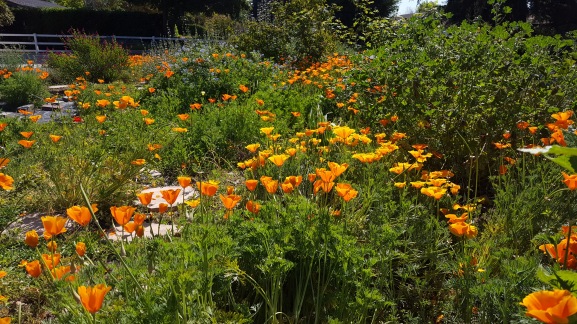 There are few flowers that I don’t like. On the same token, there are few flowers that I love. I love California Poppies.
There are few flowers that I don’t like. On the same token, there are few flowers that I love. I love California Poppies.
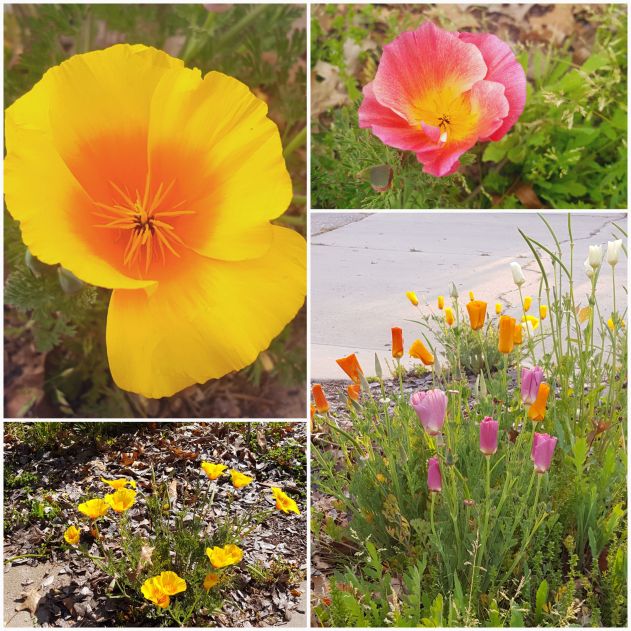 It’s not because I’m from California, mind you. Bold color on large, satiny petals that glow in the sun and wave in the breeze, what’s not to like? In the spring, the foothills of the Sierra Nevada mountain range are positively coated with the blooms of thousands of poppies. All you see are waves of orange.
It’s not because I’m from California, mind you. Bold color on large, satiny petals that glow in the sun and wave in the breeze, what’s not to like? In the spring, the foothills of the Sierra Nevada mountain range are positively coated with the blooms of thousands of poppies. All you see are waves of orange.
*A handy growing summary chart is at the end of the article.*
(All links open a new page, so you won’t lose your spot when you look around! Get information on gardening and cultural traditions, recipes, stories, and more!)
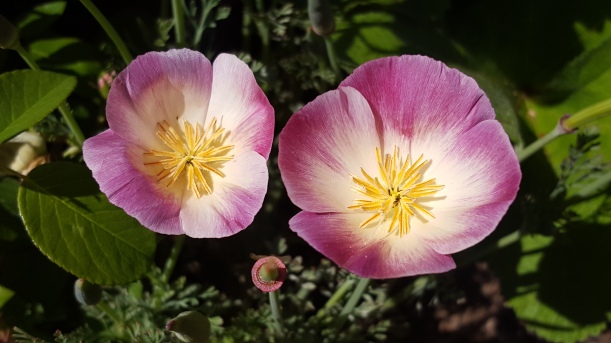 Sadly, I don’t always (actually, hardly at all) get to go see the spring time blooms of poppies up in the hills. Spring is often a ridiculously busy time for us and so, despite how close we are, we often miss out on the spectacle. Good thing poppies are just as ridiculously easy to grow!
Sadly, I don’t always (actually, hardly at all) get to go see the spring time blooms of poppies up in the hills. Spring is often a ridiculously busy time for us and so, despite how close we are, we often miss out on the spectacle. Good thing poppies are just as ridiculously easy to grow!
 Really, you don’t actually “grow” these flowers. You throw seeds out in the yard and walk away. Maybe you help by lightly raking the seeds into the soil and watering. Maybe. Mostly you walk away.
Really, you don’t actually “grow” these flowers. You throw seeds out in the yard and walk away. Maybe you help by lightly raking the seeds into the soil and watering. Maybe. Mostly you walk away.
The best time to scatter seeds is in late fall to early winter for zone 8+ gardens. This gives the seeds the right environmental cues for the proper germination time. It also allows winter rains to push them into the soil where they will be protected. Don’t bother trying to plant them for transplanting, as poppies don’t like being disturbed. For colder zones, sprinkle seeds in spring once the ground is “workable”.
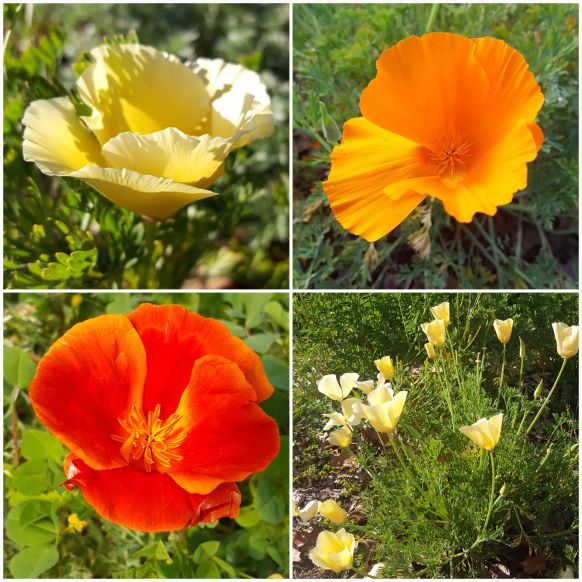 As the weather starts to warm a little in early spring, you will start to see the seedlings popping up. The leaves are lacy and almost fernlike, in a light green to greyish green color. They grow rapidly, especially with regular water. Flowers will start to appear soon after.
As the weather starts to warm a little in early spring, you will start to see the seedlings popping up. The leaves are lacy and almost fernlike, in a light green to greyish green color. They grow rapidly, especially with regular water. Flowers will start to appear soon after.
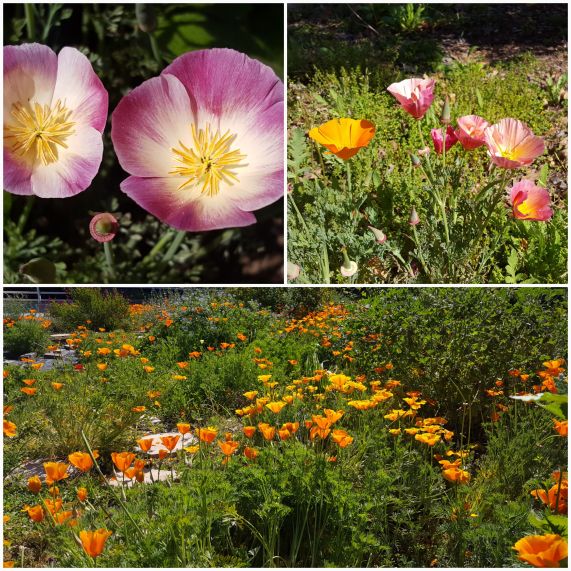 Wild poppies can be found in shades other than orange, and some modern cultivars have also brought out a variety of colors. I have pinks, oranges, yellows, cream, and reds. There are even some that are multi-hued. By mid-spring my yard rivals the color of the hills!
Wild poppies can be found in shades other than orange, and some modern cultivars have also brought out a variety of colors. I have pinks, oranges, yellows, cream, and reds. There are even some that are multi-hued. By mid-spring my yard rivals the color of the hills!
 Though California poppies are drought tolerant, you will get color all season long if they receive regular water. Though often thought of as annuals, California poppies are actually perennials. During the dry summers, the foliage dies back but the roots remain alive and dormant until the rainy season. Resist the urge to pull out older plants as they will come back again in spring, and will be much bigger and more prolific bloomers. Eventually, older plants can become a bit woody and less attractive, so you may want to take them out at that time.
Though California poppies are drought tolerant, you will get color all season long if they receive regular water. Though often thought of as annuals, California poppies are actually perennials. During the dry summers, the foliage dies back but the roots remain alive and dormant until the rainy season. Resist the urge to pull out older plants as they will come back again in spring, and will be much bigger and more prolific bloomers. Eventually, older plants can become a bit woody and less attractive, so you may want to take them out at that time.
You won’t have to do anything if you want to keep poppies around. They are prolific seed producers and will propagate readily. The seed heads are long and narrow, curved pods that eventually pop open, releasing the seeds. Not to worry, though, poppies are easy to remove if they start growing where you don’t want them.
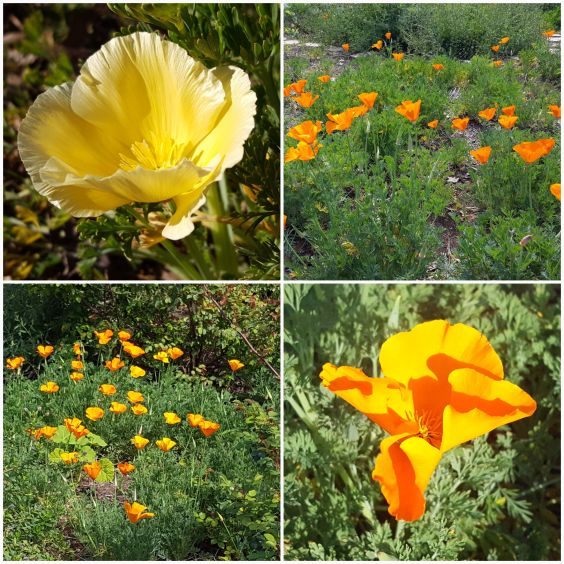
Plant Summary:
- Perrenial, but often grown as an annual
- Evergreen, but may die back in cold weather
- Flower Color: orange, red, pink, cream, yellow
- Height: up to 2 feet
- Width: up to 2 feet
- Sun: full sun
- Water: drought tolerant, will bloom longer with watering
- Soil pH: 6.5 – 7.5
- Soil type: tolerates various soils
- Key nutrients: balanced
- Planting time: scatter seeds in late fall through very early spring


Great tips! Years ago, our neighbors (transplants to California from back east) went for a drive into the foothills of central California. They picked a beautiful arrangement of wild flowers – including the golden poppies. My parents explained that those flowers were protected and it was a good thing they didn’t get caught – the fine, even back then, was a hefty one.
LikeLiked by 1 person
So true! I’ve had to explain it to others, as well. We won’t have more plants and flowers if all the future seeds get picked!
LikeLike
THEY SHOULD BE ORANGE! Remember when finding the rare white or pale purple lavenders was ‘special’? I wrote an article about them a while ago, and described how the classic ORANGE is still the best color for the. You can not improve perfection!
LikeLiked by 1 person
I have to say that the orange are my favorite, but I do like the other colors, too! I have noticed that the orange are more likely to pop up in my yard, anyway. You have to admit that the other colors are also pretty!
LikeLiked by 1 person
Well, yes, they are pretty. But that is how they start. They move in and get everyone to like them, and then they take over. They are plotting World domination right now!
LikeLiked by 1 person
Hahahaha!! Oh no, not the pink poppies! Just wait, I’ll be posting about the red European poppies soon, along wth the purple mutant. I am just waiting for them to bloom so I can get pictures.
LikeLiked by 1 person
Someone else was writing about the variants of Texan bluebonnet. They can be white, lavender, maroon or red! The maroon is the color of Texam A&M.
LikeLiked by 1 person
Sounds like it needs a different name!
LikeLiked by 1 person
Well, blue will probably always be the favorite color for them; just like most lavenders are lavender, and most lilacs are lilac, and most violets are violet, and most oranges are orange and so on.
LikeLiked by 1 person